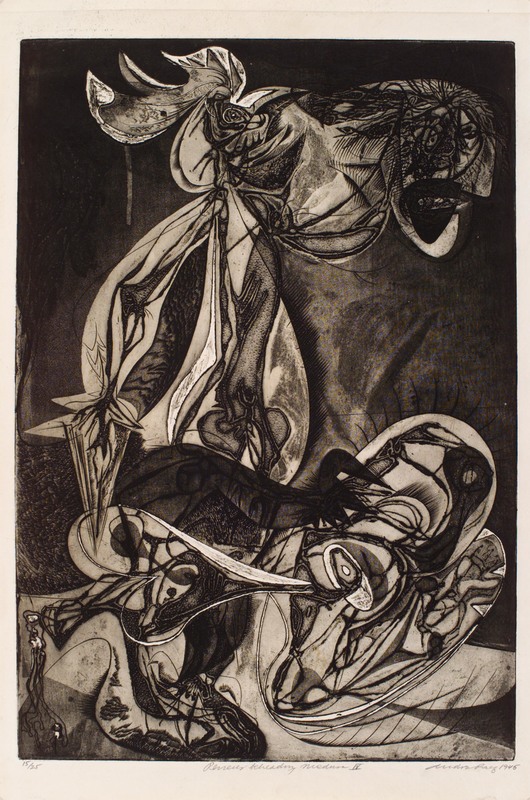Perseus Beheading Medusa IV
Item
Title
Perseus Beheading Medusa IV
Creator
André Racz
American, b. Romania, 1916–1994
American, b. Romania, 1916–1994
Date
1945
Materials
Engraving, soft-ground etching, aquatint, and gauffrage
Measurements
Plate: 21-1/2 x 14-3/4 in. (54.8 x 37.7 cm), sheet: 24-9/16 x 17-3/4 in. (62.4 x 45.1 cm)
Description
André Racz was born in Cluj, Romania. He studied art at the University of Bucharest before coming to the United States in 1938, initially as a member of the Romanian avant-garde to work on the Romanian Pavilion at the New York World’s Fair. He became an American citizen in 1948, and for thirty-two years, between 1951 and 1983, taught painting and sculpture at Columbia University in New York City.
Racz is perhaps best known today for his work at Atelier 17, where, from 1943 to 1945, he distinguished himself by creating wildly expressive and technically innovative prints, many inspired by Picasso’s distorted and anguished imagery. For Perseus Beheading Medusa, Racz first produced an automatic drawing by pouring gesso from a container upon a sheet of smooth board. After the gesso had dried, he sanded the relief to a uniform thickness, and then pressed it into a copper plate coated with a soft ground to transfer the image. Racz then etched and engraved the plate further, with aquatint and traditional burin, as well as with a scorper to gouge the copper deep enough to allow an inkless embossed line. When printed, the plate forged a rich and tonally varied image equal to the task of reflecting the macabre beheading of Medusa.
The process of printing the actual plate, recorded by fellow studio member Leo Katz, is indicative of Atelier 17’s collaborative environment:
"André Racz had just finished his Perseus plate. Lasansky was there and a few others, including myself. Someone cut the paper; another prepared the blankets. One turned spikes and I held the blankets stretched. We had forgotten whose plate it was. When finally someone lifted slowly the paper from the plate we knew we were looking at a print the like of which no one had seen before."
The text for this label has been adapted in part from an unpublished essay by former Penn State art history graduate student Barbara Kutis (MA 2007).
Racz is perhaps best known today for his work at Atelier 17, where, from 1943 to 1945, he distinguished himself by creating wildly expressive and technically innovative prints, many inspired by Picasso’s distorted and anguished imagery. For Perseus Beheading Medusa, Racz first produced an automatic drawing by pouring gesso from a container upon a sheet of smooth board. After the gesso had dried, he sanded the relief to a uniform thickness, and then pressed it into a copper plate coated with a soft ground to transfer the image. Racz then etched and engraved the plate further, with aquatint and traditional burin, as well as with a scorper to gouge the copper deep enough to allow an inkless embossed line. When printed, the plate forged a rich and tonally varied image equal to the task of reflecting the macabre beheading of Medusa.
The process of printing the actual plate, recorded by fellow studio member Leo Katz, is indicative of Atelier 17’s collaborative environment:
"André Racz had just finished his Perseus plate. Lasansky was there and a few others, including myself. Someone cut the paper; another prepared the blankets. One turned spikes and I held the blankets stretched. We had forgotten whose plate it was. When finally someone lifted slowly the paper from the plate we knew we were looking at a print the like of which no one had seen before."
The text for this label has been adapted in part from an unpublished essay by former Penn State art history graduate student Barbara Kutis (MA 2007).
Source
Palmer Museum of Art, The Pennsylvania State University
Identifier
2000.54
Rights
This image is posted publicly for non-profit educational uses, excluding printed publication. Other uses are not permitted.

